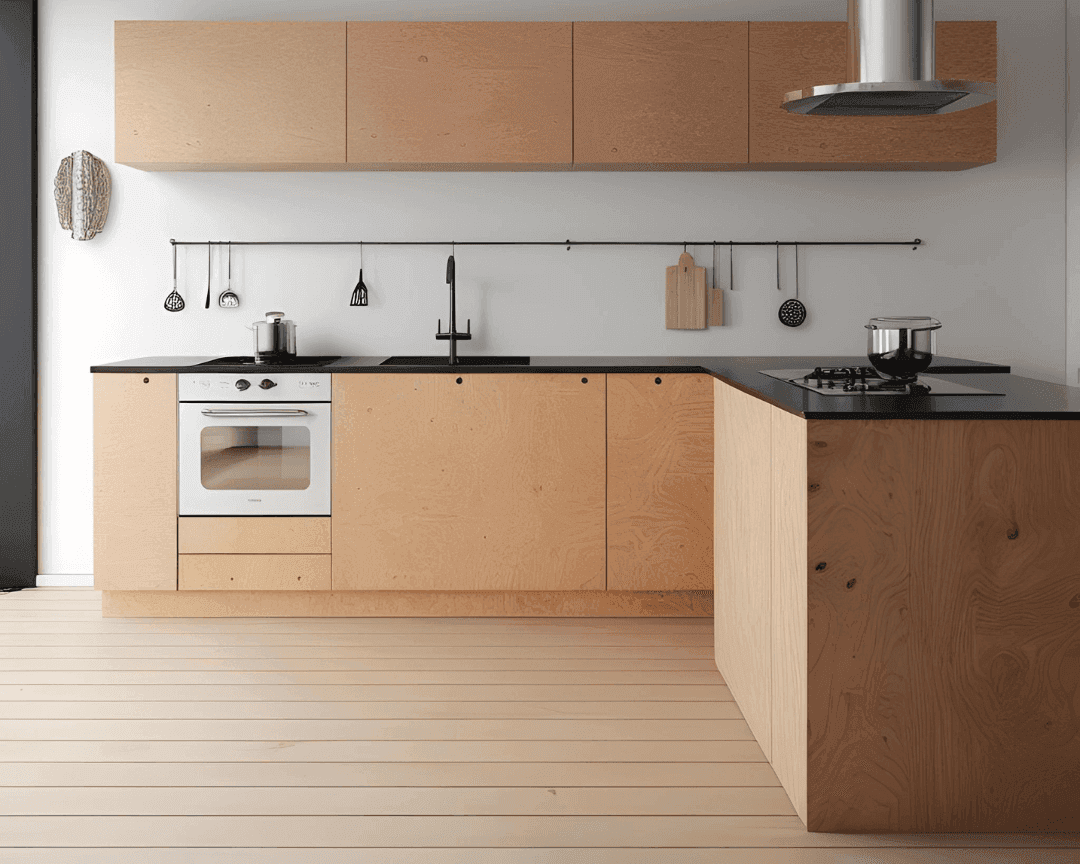
Minimalist vs Traditional: Which Plywood Kitchen Style Will You Choose?

April 30, 2025
Designing a kitchen is a huge decision, and one of the most important style decisions is to pick which style fits your aesthetic, functionality requirements and lifestyle. Two popular choices that a homeowner often contemplates are minimalist vs traditional kitchen design style. Both styles are truly timeless and lovely, but they will be different regarding layout, materials, and general feel. If you are thinking of plywood in your kitchen, then the difference in those two styles will be a strong factor in your decision. In this post, we will look at the differences between minimalist and traditional kitchen design styles and help you determine which would be better for your needs.
What Is Minimalist Kitchen Design?
A minimalist kitchen design is all about simplicity, clean lines, and decluttered spaces. The minimalist approach is very modern and functional. Minimalist kitchens focus on only the essentials of kitchen functions while removing any unnecessary decor. The minimalist aesthetic is typically sleek and elegant, with the use of neutral colors, straight lines, and high-end finishes. The minimalist plywood kitchen design will focus on understated finishes, smooth textures, and function.
Features of a Minimalist Kitchen Design
Clean and Minimalist Lines
Minimalist kitchens will feature sleek cabinetry and clean countertops that may not even have hardware if the cabinet doors are designed to have no hardware.
Neutral Color Scheme
The typical minimalist kitchen uses white, gray, or other neutrals allowing the design to feel open and airy.
Functional Design
Every design element will be chosen ahead of time with appearance and functional needs in mind which will create an efficient and orderly space.
Quality Materials
Plywood is frequently selected for kitchen cabinets because of its sleek appearance, durability, and compatibility with modern design elements.
Minimalist kitchen designs work best in smaller living spaces or where aesthetic is driven by modern home interior designs, where the objective is to maximize limited space while still achieving a tidy and orderly appearance. Minimalism look and feel is ideal for individuals that prefer functionality and simplicity over embellishment and ornamentation.
What Is Traditional Kitchen Design?
In contrast, a traditional kitchen design embraces elegance, warmth, and comfort, often adorned with details, rich wood tones, and decorative features. Traditional kitchens are oriented around timelessness and classic appeal. When plywood is selected for the kitchen design in traditional décor, it is commonly detailed, paired with vintage decorative hardware and warm wood finishes that create warmth and nostalgia.
Features of Traditional Kitchen Design
Ornate Detailing
Traditionally designed kitchens will display decorative moldings, raised panel cabinets, and decorative finishes.
Warm Color Palette
Rich color tones such as cherry, mahogany, or walnut are typical for producing an inviting/comfortable feel to the kitchen.
Classic Layouts
Traditional kitchens tend to display a more conventional layout, representing the U-shape or the L-shape layouts to create a social and family-friendly atmosphere.
Detailed Finish
The use of plywood for kitchen designs in traditional spaces can present in detailed grain patterns, distressed finishes and soft rounded edges to display more of the classic aesthetic.
Traditional kitchen designs appeal to larger living spaces or homes that place an emphasis on character, heritage and timeless is perfect for those who enjoy warmth, ornate design features, and a homey feeling.
The Important Differences Between Minimalist Kitchen Design and Traditional Kitchen Design
Knowing the differences between minimalist kitchen design and traditional kitchen design is critical in discovering the style best for your kitchen. Consider the following points-
Style of Design
Minimalist kitchens
The focus is on simplicity, neutral, and functionality. Minimalist kitchens are sleek with smooth finishes and textures that are simple.
Traditional kitchens
Traditional kitchen design utilizes rich textures and intricate details. Traditional kitchen designs convey a timeless feel that is both warm and welcoming.
Space & Design Layout
Minimalist kitchen
Minimal kitchens typically allow for a smaller, modern space where kitchen design allows for minimal layouts and materials, while also using every inch of space efficiently for storage and function.
Traditional kitchen
Traditional kitchen design typically allows for larger spaces and larger design layouts that create more space for plentiful cabinetry and decorative style above what is expected.
Materials & Finishes
Minimalist kitchen
Clean, simple surfaces and textures are the main priority. Bathroom cabinetry made of plywood is common, and finishes are smooth, refined, and harmonious with the minimalist approach.
Traditional kitchen
Plywood is still common, however it often has more detailed grain patterns, darker stain, and finish with paint colors that help evoke that timeless design style.
Decor & Details
Minimalist kitchen
The design expresses minimal decorative approaches with basic and functional pieces.
Traditional kitchen
Expect rich detailing, decorative mouldings, or vintage hardware to give charm and character to the space.
How to Use Plywood in Your Kitchen Design
No matter if you lean toward minimalist or traditional kitchen design, plywood for their kitchen design allows for a great deal of versatility. This is how to interpret it into both styles.
Minimalist Plywood Kitchen Design
Sleek, Smooth Finishes
Select high-quality plywood that has a smooth, uniform surface. Use basic finishes such as clear lacquer or matte varnish to keep with a minimal look.
Light, Neutral Tones
Lighter-colored plywood such as birch or maple will create a clean, fresh look in the minimalist kitchen that makes it feel bigger and airy.
Storage Hidden From View
For a simple, minimalist kitchen, plywood cabinetry may have concealed handles or touch-latch hardware to maintain a clean aesthetic.
Traditional Plywood Kitchen Design
Rich, Detailed Finishes
For traditional kitchens, plywood veneer can look like a rich hardwood. Use stain colors such as walnut, cherry, or other deep tones to provide a warm, classic look.
Decorative Details
Traditional kitchens are known for their decorative features, including moldings, raised-panel cabinet doors, vintage hardware, and finely detailed trim work. Plywood can be used as a base material and then dressed up with these classic finishes.
Warm, Inviting Ambience
Dark-colored plywood can create a more inviting and homey feel. Use warm lighting and decorative accessories to enhance this warm, friendly atmosphere.
Which Kitchen Design is Right for You?
Deciding between minimalist vs. traditional kitchen design will depend on personal preferences, available space, and functionality.
Minimalist kitchen design is better for
Smaller spaces or apartments where all available space counts. Homeowners looking for a clean, uncluttered space. For those who appreciate functionality, simplicity, and modern designs.
Traditional Kitchen Design is suitable for:
Larger spaces with ample opportunity for more complex design elements. who enjoy deep-toned wood finishes, decorative features, and a familiar, warm feel. Those desiring a resemblance of a design that will always remain in style and warm character to your home.
Conclusion
Minimalist kitchen designs and traditional kitchen designs are visually appealing options. The difference between minimalist and traditional kitchen design is in the space, materiality, and overall aesthetic. Plywood for kitchen can be a good option for use in either option, providing durability and versatility. Either option can help create beautiful kitchen spaces with an appearance that should suit your flavor and purpose.
Frequently Asked Questions
What is the difference between minimalist vs traditional kitchen designs?
The difference between minimalist and traditional kitchen design is in the aesthetic. Minimalist designs are noted for their clean lines, neutral colors, and keeping things simple. Traditional kitchens note the richness of wood finishes, decorator features, and a warm feel to space.
Is plywood a good finish for kitchen designs?
Yes, it is. Plywood for kitchen designs, especially in styles that keep materiality a feature, works great to provide durability, and versatility in design for minimalist and traditional styles.
How do I choose between minimalist vs traditional kitchen designs?
Choosing between minimalist vs traditional kitchens depends on the space, lifestyle, and preference. Minimalist kitchens are best suited for small and modern homes or inside modern spaces, whereas traditional kitchens are better for larger and more classical homes.
Is plywood useful for both minimalist and traditional kitchen styles?
Yes, a plywood kitchen design can work for both minimalist and traditional kitchens, where in minimalist designs, you’ll want a rich smooth surface in simple lines. In traditional kitchens you’ll want to have more than minimally finished in rich features or decorative features finding balance somewhat between minimalist lines and traditional richness.
What are the benefits of a modular kitchen with plywood?
How to maintain modular kitchen design benefits with plywood are durability and flexibility. Plywood allows you to create modular units to fit your kitchen with high-end, durable design features.
Related Blogs
10 Ways to Maintain Your Clean Kitchen
Kitchen plywood: which plywood is best for modular kitchen
Is Marine Plywood Good for Kitchen Cabinets?
Why is BWP Plywood good for kitchens?
16mm Plywood for Kitchens & Bathrooms
